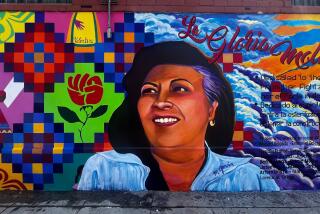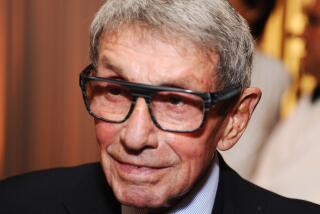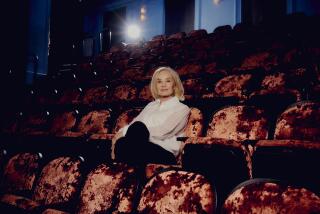Review: ‘Stella!’ is a backstage portrait of acting guru Stella Adler
The exclamatory title of Sheana Ochoa’s biography of legendary acting teacher Stella Adler invokes Marlon Brando’s tormented cry in “A Streetcar Named Desire.” It’s a fitting allusion: Brando was Adler’s most famous pupil, and his endorsement of her teaching over Lee Strasberg’s Method was a crucial victory in the rancorous war between these two American interpreters of Stanislavsky’s revolutionary system of acting training.
Adler and Strasberg’s bickering began at the Group Theatre, the groundbreaking Depression-era collective that Strasberg formed with Adler’s future husband, director Harold Clurman, and producer Cheryl Crawford, aimed at endowing the America theater with a political conscience and promulgating a startling new brand of realism. The daughter of international Yiddish theater star Jacob Adler, she was far too imperious to defer to Strasberg, who was working out his theory of affective memory, the mining of an actor’s private experience for the attainment of a more acute realism.
What could Strasberg teach Adler that she hadn’t already learned as a girl acting with her nearest and dearest on stage? She was born, as she said, “into a kingdom,” a princess of the Yiddish theater. To her temperamental mind, Strasberg was an interloper preaching a psychological technique that wasn’t only impractical but injurious to the longevity of a performer.
After studying firsthand with Stanislavsky in Paris, Adler contended that Strasberg had badly misinterpreted the Russian master. She returned to the Group Theatre with an urgent corrective: The actor must imaginatively enter the circumstance of the play, concentrating on the actions of the character, not his or her own childhood hurts and resentments.
“To go back to a feeling or emotion of one’s own experience I believe to be unhealthy,” Adler explained in 1966 after she had established herself as one of the foremost acting teachers in the country. “It tends to separate you from the play, from the action of the play, from the circumstances of the play, and from the author’s intention.”
Ochoa valuably reviews this still-simmering debate and offers a vivid sketch of the burgeoning, early 20th century Yiddish theater of New York’s Lower East Side that gave rise to the socially conscious realism ushered in by the Group Theatre an assimilated generation later. The book, however, suffers from imprecision, in both its language and its factual detail, which undermines its narrative’s authority.
“Realism,” Ochoa shakily claims, “took hold in art and literature by the mid-1900s” — a half-century after Strindberg, Ibsen and Chekhov liberated the theater from melodrama. She refers to the Actors Studio as “the most famous acting school in the United States” when it most emphatically isn’t a school but a workshop for professional actors. She lumps the absurdism of Eugène Ionesco in with the realism of Ibsen, Shaw, Miller and Williams. (Shaw’s inclusion is equally problematic.) And her interpretation of Hedda Gabler’s suicide (“She takes her life not to escape marriage, but to be daring enough to do something truthful”) borders on zaniness.
Carelessly edited, the biography contains banal quotations at the top of chapters (“Stella is an American Treasure.” — Antonio Banderas) that seem randomly chosen. Information about Adler’s political activism that got her blacklisted, her extensive FBI file and her involvement with “a militant, political movement for the creation of Israel” could have been presented more coherently.
Adler is portrayed as a complicatedly charismatic force of nature, a prickly beauty who worshipped her father to the detriment of her relationships with men. (The point that she was forever seeking the approval he withheld from her is made repeatedly.) Although she had success on stage (winning acclaim for her performance in the Broadway premiere of Clifford Odets’ “Awake and Sing!” and inspiring the young Arthur Miller), Adler found true stardom in the studio in the role of the flamboyantly irascible acting guru, insistently defending an elusive ideal.
The theater schools in New York and Los Angeles bearing her name have trained numerous luminaries, including Mark Ruffalo, who in his brief foreword identifies what may be the most important lesson this demanding diva instilled in her charges: “For her, the theater was where we really learned about mankind and how we were supposed to be in the world.”
It’s a fitting tribute to a teacher who, however much she fell short in her own life, held fast to the view that “growth as an actor and growth as a human being are synonymous.”
Stella!
Mother of Modern Acting
Sheana Ochoa
Applause Theater & Cinema Books: 327 pp.,$29.99
More to Read
Sign up for our Book Club newsletter
Get the latest news, events and more from the Los Angeles Times Book Club, and help us get L.A. reading and talking.
You may occasionally receive promotional content from the Los Angeles Times.









